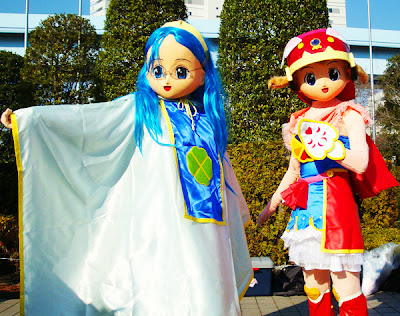Kigurumi (着ぐるみ) is a term for masked full body costuming in Japan. Costumes range from animals to "giant" robots to cartoon characters. Most people are familiar with kigurumi through performers at major theme parks such as a full Mickey Mouse costume at Disney World. In Japan there are hobbyists who perform kigurumi for fun at costuming and related events such as Wonder Festival in Chiba. Held twice a year, Wonder Festival is Japan's largest amateur figurine & sculpting convention. With the focus of the event being on amateur craftsmanship, costuming has become a growing side feature of the convention. Animegao (アニメ顔), literally animation face, is a subset of kigurumi where full body costumes of Japanese animation and game characters are worn, although the term animegao is not preferred by the performers themselves. Note performer is used, not costumer. This is because, like the Mickey Mouse performer at Disney World, amateur performers dressed as anime characters never speak when in costume and act the part of their character through exaggerated body movements when engaged by a spectator. Most costumes are of female characters and the majority of people involved in the hobby are men. But I saw two kigurumi costumers with their masks off who were women while at Wonder Festival. Those men who I have talked to, despite wearing female costumes, are heterosexual and don't see the wearing of the mask as a way of cross dressing while remaining anonymous. This is very believable since more men openly dressed as female characters without a mask than there were those in kigurumi. The kigurumi hobbyists viewed the costumes as being as authentic to a figurine or character as a costume can be and enjoy the performance side of it since as a man, they can bring out the desired feminine attributes of the character in only the way a male can much like a Kabuki actor.





No comments:
Post a Comment